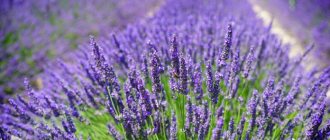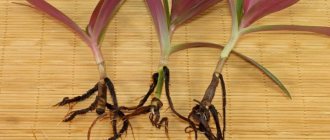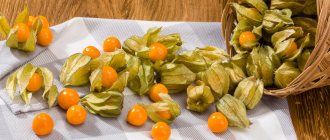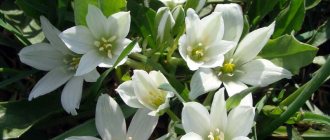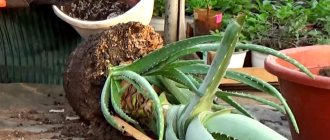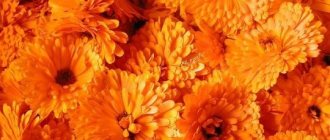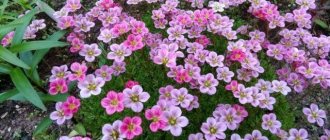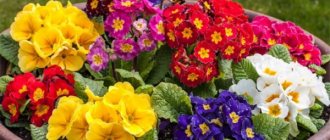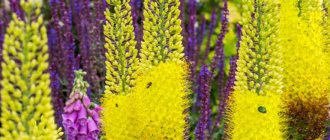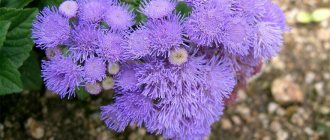Author: Elena N. https://floristics.info/ru/index.php?option=com_contact&view=contact&id=19 Category: Garden plants Published: January 13, 2019Last edits: November 18, 2021
- Growing conditions
- Wintering
- French lavender (Lavandula stoechas)
- Medicinal properties
plant (lat. Lavandula) belongs to the genus of the Lamiaceae family, which includes about 30 species. The lavender flower grows naturally in the Canary Islands, East and North Africa, Australia, Arabia, India and southern Europe. There are only two types of lavender grown in cultivation around the world - broadleaf lavender (French) and angustifolia lavender, or medicinal (English). The name of the plant comes from the Latin lava, which means “to wash” and indicates the purpose of lavender in the Ancient world - the Romans and Greeks used the plant for washing and washing. Today, lavender flowers grow not only in private gardens, but are also grown on an industrial scale as a valuable essential oil crop.
Planting and caring for lavender
- Planting: sowing seeds in the ground - in October, sowing seeds for seedlings - in February or March, planting seedlings in the ground - in late May or early June.
- Flowering: in the second half of summer.
- Lighting: bright sunlight.
- Soil: dry, drained, sandy or loamy, pH 6.5-7.5.
- Watering: regular and plentiful, frequent during drought.
- Fertilizing: twice a season: in the spring – with a mineral complex with a high nitrogen component, in the fall – with potassium-phosphorus fertilizers.
- Hilling: in spring and autumn you need to hill up old bushes high.
- Pruning: after flowering, cut off the inflorescences, and shorten the branches in the fall. When the bush reaches ten years of age, the bush is rejuvenated by cutting off all branches at a height of 5 cm from the ground.
- Reproduction: by seeds and vegetatively - layering, cuttings and dividing the bush.
- Pests: leafhoppers (slobbering pennies), rainbow beetles and aphids.
- Diseases: gray rot.
Read more about growing lavender below.
5.Collecting lavender
Since in most plants the highest concentration of nutrients is achieved at the beginning of flowering, lavender is harvested when approximately half of the flowers bloom - in the first half of summer. For collection, choose a dry and fine, warm day. The stems are cut in the morning, to a quarter or even a third of the length with sharp pruning shears and sent for drying and storage. During the midday hours, most essential oils may evaporate and the branches will not be as useful and fragrant.
Dry the plant in a warm and well-ventilated place, out of direct sunlight. The stems are tied in the form of small bouquets and hung upside down or laid out in a small layer on racks. It is believed that different varieties with different colors of flowers should not be mixed when drying. Store dry lavender in fabric or paper bags. allowing the raw materials to breathe - in such conditions the pleasant aroma of the branches will remain for several years.
↑ Up,
Botanical description
Lavender is a perennial evergreen shrub with a woody fibrous root going 2 meters deep, numerous woody shoots in the lower part reaching a height of 60 cm, opposite sessile linear silvery-greenish leaves with soft pubescence and fragrant blue or blue-lilac flowers collected into interrupted spike-shaped inflorescences, 6-10 pieces in whorls. Inflorescences form on the tops of leafless stems. Lavender begins to bloom in the second half of summer. Lavender is an excellent honey plant. When properly stored, lavender seeds can remain viable for many years.
Lavender is a relative of such crops as hyssop, basil, mint, lemon balm, motherwort, oregano, sage and rosemary. We will tell you how to grow lavender from seeds, what are the conditions for growing lavender in open ground, how lavender is planted and cared for in open ground, how to propagate lavender, how lavender winters in Moscow and we will give a lot of interesting and useful information about this garden plant.
Preparing lavender for winter
As for wintering, the most common English lavender in our gardens can easily survive frosts in the open ground. But its French relative is much more spoiled and sometimes freezes, so it is better to grow it in pots that can be quickly taken to a warm room.
In any case, it is worth taking care of the shelter. The branches of coniferous trees will save lavender from severe frosts (the plant should be pruned first). You need to build a warm hut from them in October - early November. Covering lavender with leaves is not recommended as this may cause it to rot.
Lavender is great for creating borders and edgings, looks wonderful in pots, and can also act as a background plant. The smell of lavender also repels pests such as the Colorado potato beetle and moth. Therefore, the plant can be planted not only in the flowerbed, but also in the garden.
Lavender is an excellent honey plant that can attract beneficial insects to your garden.
Planting lavender in open ground
When to plant
Lavender is planted in the ground either with seeds in October or seedlings at the end of May. In order to grow lavender from seeds, seed material should be purchased at the beginning of winter or autumn, since before sowing in the ground, the seeds are stratified for 2 months at a temperature of 5 ºC to increase germination. Typically, seeds mixed with wet sand are stratified in the vegetable drawer of the refrigerator. Sow lavender seeds for seedlings in February or March.
- Growing alyssum seedlings
Seedling care
While the seeds are in the refrigerator, prepare a container for sowing and a substrate for the seeds by thoroughly mixing two parts of humus with one part of coarse river sand. Sift the mixture - lavender seeds are very small, so the substrate should not contain any lumps - and bake it in the oven at a temperature of 110-130 ºC or pour it with a bright pink solution of potassium permanganate. Place the treated soil mixture in a growing container with drainage holes on a drainage layer.
In the photo: Lavender blooming in the field
At the very end of winter or at the beginning of spring, sow lavender seeds on the surface of the substrate in a container, sprinkle them with a 3 mm thick layer of sand, spray them with warm water from a spray bottle, cover them with glass or plastic wrap to create a greenhouse effect and place them in a bright, warm place. From time to time, crops need to be ventilated by lifting the cover. Seeds are germinated at a temperature of 15-22 ºC.
How to grow lupine in the garden - a beautiful flower and green manure
How to care for lavender during the seedling period? As soon as the seedlings appear, you will have to provide them with additional lighting so that the lavender seedlings do not stretch out. Remove the covering every day for a while so that the seedlings get used to the temperature in the room, and as soon as they adapt to it, the film can be removed completely and the seedlings can be planted so that the distance between them is at least 5 cm.
How to plant in the ground
At the end of May, it is time to plant lavender in the garden. Most often, lavender is used to decorate alpine slides, use it as a border, or plant it on both sides of paths. Lavender grows well in bright sun. Do not plant it in wetlands or areas with high groundwater levels, as lavender is very sensitive to excess moisture. The plant prefers dry, sandy soil, but also grows well on loamy soils with good drainage.
The optimal acidity level for the plant is 6.5-7.5 pH. Ground limestone will have to be added to acidic soil. Before planting lavender, you need to prepare the area: dig up to a depth of at least 20 cm and loosen the soil well, adding peat or compost for digging.
How to plant lavender? Lavender is planted with a distance of 80-90 cm between seedlings, and a distance of 120 cm is maintained between bushes of tall lavender. The depth of the hole should be such that the root system of the seedling can freely fit into it. Before planting, the roots are slightly trimmed, then the lavender bush is placed in the hole and buried, deepening the root collar by 4-6 cm. After planting, the lavender seedlings are watered abundantly.
In the photo: Growing lavender in the garden
Pre-winter sowing
In areas with warm winters, it is better to sow lavender seeds directly into the ground. This is done in October, after they have prepared the soil on the site by adding peat for digging, and if the soil is too wet, then fine gravel or sand is added to it to increase moisture and air permeability. Seeds are sown to a depth of 3-4 cm, slightly compacting the soil surface after sowing. If autumn is dry, water the crops, but not too much, and with the first snow, throw a small snowdrift over the area.
Growing lavender from seeds
Planting in open ground
Lavender seeds can be sown directly in open ground before winter, or more precisely in October. If you grow it through seedlings, then the seedlings are planted in the garden in the last days of May. If you decide to grow such a shrub from seeds, then you need to purchase them in advance, or rather, in the first weeks of winter or early autumn. The fact is that before you start sowing the seeds, they need to be prepared. To do this, the seed material is stratified for two months at a temperature of about 5 degrees, which significantly increases its germination. To do this, the seeds must be combined with moistened sand and placed on the refrigerator shelf intended for vegetables. Sowing seeds for seedlings is carried out in February–March.
Sowing seedlings
The container intended for sowing lavender must be filled with a pre-prepared substrate, which should include coarse river sand and humus (1:2). Since the seeds of such a plant are very small, the finished soil mixture should be sifted, which will help remove all lumps from it. Then the substrate is disinfected, for this it is spilled with a rich pink solution of potassium permanganate or calcined in the oven at a temperature of 110 to 130 degrees. A drainage layer is first laid at the bottom of the box, which has holes for drainage, after which it is filled with the prepared substrate.
Stratified seed material is evenly distributed over the surface of the soil mixture, after which it is sprinkled with a three-millimeter layer of sand. Moisten the crops with warm water from a spray bottle and cover them on top with transparent film or glass. Place the box in a warm and well-lit place. Crops need systematic ventilation; for this, every day you need to briefly raise the shelter. In order for seedlings to appear, crops must be at a temperature of 15 to 22 degrees.
Seedling care
Immediately after the seedlings appear, they need to be regularly illuminated, otherwise they will stretch out very quickly. The plant must be accustomed to new growth conditions gradually. To do this, you need to remove the shelter for a while every day, and the duration of the procedure should be increased gradually. Immediately after the seedlings get used to the new growing conditions, the shelter can be removed altogether. After this, the lavender must be planted in a larger box so that the distance between the bushes is at least 50 mm.
Growing LAVENDER seedlings from seeds
Planting in open ground
Seedlings are planted in open soil in the last days of May. Often this shrub is used to decorate alpine slides, to create borders, or it is planted on both sides of paths. The culture grows well in open sunny areas. Since lavender reacts extremely negatively to excess moisture, it is not recommended to choose an area with a high level of groundwater or wetlands for planting it. Dry sandy loam soil is perfect for growing it, but it also grows quite well in well-drained loamy soil. The recommended pH of the soil on the site is 6.5–7.5. If the soil is acidic, then crushed limestone should be added to it.
Before planting, the area should be thoroughly prepared. To do this, it is dug up to a depth of at least 0.2 m, and then the soil is well loosened, for this purpose compost or peat is added to it.
When planting seedlings of vigorous varieties, a distance of about 1.2 meters is maintained between the bushes. When planting seedlings of other varieties, the distance between plants should be from 0.8 to 0.9 meters. The planting hole is made so deep that the bush’s root system can fit into it. Before planting the seedling, its roots need to be trimmed a little, after which the bush is placed in a hole and covered with earth. After planting, the root collar should be buried 40–60 mm into the ground. Planted seedlings need abundant watering.
Pre-winter sowing
In regions with a mild climate and warm winters, it is recommended to sow seeds directly into open ground. Sowing is carried out in October in a previously prepared area. To do this, they dig it up and at the same time add peat to the soil. If the soil is excessively wet, this can be corrected by adding sand or fine gravel to it, which will increase its drainage properties. The seeds are buried 30–40 mm into the soil, after which the surface is slightly compacted. If the autumn turns out to be dry, the crops are watered moderately. When the first snow falls, they should cover the surface of the area so that the result is not a very large snowdrift.
Sowing Lavender before winter
Caring for lavender in the garden
Growing conditions
As soon as the first inflorescences appear on lavender seedlings, it is advisable to remove them so that young plants, without wasting energy on flowering, can grow stronger and grow a powerful root system. The first year lavender grows very slowly in the garden, so it is necessary to fight weeds that can choke the seedlings. How to grow lavender? What kind of care does lavender require in the garden? You will need to water the plant regularly and deeply, and in extreme heat, watering should become frequent. After watering or rain, it is necessary to loosen the soil between the bushes and weed the area, but if you want to save time and effort, mulch the soil between the bushes with peat after planting.
How to grow a rose by saving cuttings from a bouquet
Old bushes should be hilled high in spring and autumn - this measure promotes the formation of new shoots on old branches. In addition to the listed procedures, you will have to trim the lavender and add fertilizing to the soil, giving preference to potassium fertilizers, since manure and nitrogen fertilizers only promote the growth of greenery, but inhibit the flowering of lavender, for which, in fact, it is grown.
In the photo: Lavender field
Trimming
Growing lavender will require you to prune the plant annually. As soon as flowering ends, cut off the faded inflorescences, and in the fall, shorten the branches, maintaining the shape of the bush.
Do not let the lavender stretch upward too much, because in windy weather its bushes will lie down and lose their decorative effect.
- Foxglove: growing from seeds, types and varieties
When the bush reaches ten years of age, it is advisable to carry out anti-aging pruning, shortening all branches to 5 cm. The same can be done with a young bush if its flowering is not lush.
Reproduction
Lavender propagates, in addition to the seed method, also by dividing the bush, layering and cuttings.
If you already have a lavender bush on your site or you managed to get a one-year-old woody shoot of a plant from someone, you may well get lavender from cuttings. Cut cuttings 8-10 cm long from the shoot, plant them in moist, loose soil, deepening the lower cut by 2-3 cm, and cover with glass jars. You can remove the jars when the cuttings take root.
In order to divide a lavender bush, it needs to be prepared for this. In the fall, after flowering, a large bush is cut at a height of 10 cm and hilled, filling all the space between the shoots with earth. In the spring, hilling is repeated. During the summer, the bush produces abundant growth. In the fall, the bush can be dug up, divided into parts with well-developed roots and shoots, and planted.
To propagate by layering in the spring, several shoots are bent back, placed in grooves 3-4 cm deep, secured in this position, covered with soil and watered. All summer the soil above the cuttings is kept moist, and next spring the rooted shoot is separated from the bush, divided into parts and transplanted to a permanent place.
Pests and diseases
Lavender in open ground is extremely resistant to both diseases and pests, but it is not immune to problems. Sometimes lavender can suffer from leafhopper, or slobbering pennies, and rainbow beetle, and among diseases, lavender can be affected by gray rot.
In the photo: How lavender blooms
Cicadas and rainbow beetles will have to be collected by hand, after which you should definitely change the layer of mulch in the area. And gray rot, which usually appears in damp, rainy summers or in cases of chronic waterlogging of the soil by too frequent watering, cannot be cured, but the diseased parts of the lavender can be removed and burned so that the infection does not spread to all plants. And, of course, you need to reconsider the lavender watering regime.
Lavender in Moscow and Moscow region
With full confidence in success in the conditions of Moscow and the Moscow region, you can only grow English lavender - narrow-leaved, or medicinal. Planting and caring for lavender in the middle zone is carried out according to the same principles and in almost the same time frame as in warmer areas. Seeds are sown in the ground when surface frosts have passed - in the second half of May, and seedlings are planted in early June. Sowing seeds before winter is risky - they may freeze.
Diseases and pests
Lavender in the garden is susceptible to diseases and pests.
Fusarium wilt
The disease can appear on rooted cuttings and adult plants. It consists of yellowing and darkening of the lower part of the cuttings or wilting of adult bushes. The causative agent is a fungus from the genus Fusarilum. It enters the plant from the soil.
As a preventive measure, you should carefully consider the composition of the soil for cuttings and its temperature, which should not fall below +8°C. 30 days before planting the cuttings, the soil is treated with carbothione (125 g/sq.m.) or thiazone (100 g/sq.m.). The latter is mixed with sand in a 1:1 ratio before application.
Fomoz
The stems are affected by the fungus Phoma lavandulae Gabotto, resulting in the formation of yellow spots that gradually turn gray. The stem is covered with black spots. High humidity promotes the spread of the disease. To protect other plants, all affected shoots should be cut out and treated with 3% Bordeaux mixture.
Septoria
Fungi Sepioria lavandulae settle on leaves. In the place of their colonies, red-brown spots are formed, which over time become covered with black dots of pycnidia. The leaves fly away, and the spores remain overwintering. Next year you may lose some of the flowers. As preventive measures, the same drugs are used as for Phomasis.
Alternaria blight
The above-ground parts of the plant are covered with velvety dark green spots. The leaves gradually dry out. The spread of the fungus Alternaria alternata (Fr.) Keissler is facilitated by wet weather. To combat the disease, it is important to urgently treat lavender with 3% Bordeaux mixture.
Botrytis
The stems and inflorescences begin to turn brown and become covered with a grayish-brown coating. Cool, rainy weather promotes fungal development. Plantations can be saved by preventive measures. For this purpose, zineb or copper oxychloride is used. Treatments are carried out at intervals of 2 weeks. If the disease develops during budding, treatment is carried out with copper oxychloride.
Slobbery Penny
The mountain plant does not like strong humidity and therefore suffers from pest invasion when there is excessive humidity. The pennitsa occupies the lavender plantings, and it has to be collected manually. You can try rinsing it off with a stream of water.
Caring for lavender after flowering
Wintering
If in your area the temperature in winter can drop below 25 ºC, you need to reliably protect the area with lavender from frost, but do not use fallen leaves as insulation, since the lavender under it may rot in winter. It is best to cover the lavender bushes with spruce branches after autumn pruning.
In the photo: Blooming lavender field
In areas with not so cold winters, angustifolia lavender is not covered.
Lavender Festival - Where to Stay
#1. Au Ralenti du Lierre, Gordes
To feel 100% in the south of France, choose a guest house in a traditional Provence style. The atmosphere is consistent both in the rooms and in the appearance of the ancient building. They greet you like family and the food is delicious! The Abbey of Senanque is just 10 km away.
We are going to the lavender festival - Hotel Au Ralenti du Lierre
#2. Le Jas de Gordes, Gordes
A little less budget, but still a romantic option. Suitable for a honeymoon or just a gift for yourself and your loved ones. A villa with a very beautiful area, delicious cuisine and proximity to lavender fields. Read more: what is the town of Gord famous for?
Where to Stay in Provence – Le Jas de Gordes
#3. La Maison des Ocres, Roussillon
In the city of Roussillon (this is the center of the Luberon province) there is an inexpensive hotel where you can stay for at least one night or a week. Nice hosts, food, rooms with everything you need. A few minutes from the famous Ocher Road. Read more: holidays in Roussillon 2022.
Lavender Festival in Roussillon – La Maison des Ocres
#4. Ancienne Maison des Gardes, Lourmarin
The guest house is suitable for a one-night stay between “forays into the fields.” The rooms are stylish, everything is clean and tidy. Each room has a coffee machine and free Wi-Fi. The grounds are well-kept, a real Provençal house in the village.
Where to Stay in Provence – Ancienne Maison des Gardes
#5. Hotel Le Manoir, Apt
Located in the town of Apt, in the same Luberon valley. During the Lavender Festival, prices in Provence skyrocket, so this option is attractive for the cost. Budget hotel with excellent reviews. Why not an option for one night? Read more: What are Apt markets famous for?
Cheap hotels in Provence - Hôtel Le Manoir
Types and varieties
So far, only such types of lavender are grown in cultivation as lavender angustifolia (English) and French lavender, also known as broadleaf. But since there are other types of lavender suitable for cultivation, we offer you a description of them. So:
French lavender (Lavandula stoechas)
Or broadleaf lavender (Lavandula latifolia) native to South-West Europe. It is distinguished by its strong aroma and beauty of flowers in different shades of purple, pink, lilac, green, burgundy and white. Flowering in French lavender begins earlier than in other plant species - in April or May - and continues until July, but at the end of summer, broadleaf lavender can bloom again. French lavender is not as cold-hardy as English lavender, so it is grown mainly in warm areas.
The most popular variety of this species is Lavandula stoechas pedunculata, or "butterfly" (Papillon), with flowers of an original shape. The most famous varieties of broadleaf lavender are:
- Yellow Vale is a variety with dark purple flowers, crimson bracts and yellow-green leaves;
- Regal Splendur - a variety with dark purple flowers;
- Rocky Road is a new variety with large lilac-blue flowers that bloom in July;
- Tiara - large blue flowers with cream bracts;
- Helmsdale is a variety with lilac-burgundy flowers.
In the photo: French lavender (Lavandula stoechas)
Hybrid lavender (Lavandula x intermedia)
Or Dutch lavender is a group of highly decorative hybrids between English lavender and other species of the genus. These are large plants with silvery narrow leaves and large oblong flowers on long peduncles that bend under the weight of the flowers. Hybrid lavender begins to bloom in July.
- Carnation Shabo: growing from seeds, planting and care
The most famous varieties of Dutch lavender:
- Alba is a variety with white flowers;
- Arabian Knight - a variety with flowers of dark blue or dark purple color;
- Sawyers - form with light purple flowers;
- Grosso - a variety with large flowers of a lilac-violet hue;
- Richard Gray is a compact bush with dark purple flowers.
In the photo: Hybrid lavender (Lavandula x intermedia)
Toothed lavender (Lavandula dentata)
Comes from the Mediterranean. This is a heat-loving compact plant with soft, rugged leaves of a silvery hue and large, fragrant flowers that open in July. The plant is not cold-resistant. The most popular variety of scalloped lavender is Royal Crown, a plant with purple flowers.
In the photo: Toothed lavender (Lavandula dentata)
Lavender angustifolia (Lavandula angustifolia)
Either English lavender (Lavandula spicata) or lavender officinalis (Lavandula officinalis) comes from Southern Europe. It is a perennial shrub with silver-green leaves and small bluish-lilac flowers that bloom in July or August. This is the most winter-hardy type of lavender. The most famous variety of angustifolia lavender is delphinium lavender, which reaches a height of no more than 30 cm, but has very beautiful silvery foliage. Hidcoat lavender is also widespread and is used mainly for low hedges.
Among the varieties of English lavender, the most popular in culture are:
- Alba - a variety up to 50 cm high with white inflorescences;
- Rosea is a bush up to 40 cm high with lilac-pink flowers;
- Manstead is a bush about 40 cm high with deep blue flowers;
- Hidcoat Giant is a compact plant up to 60 cm high;
- Hidcoat Blue is a compact bush up to 40 cm high with blue-violet inflorescences.
In the photo: Narrow-leaved lavender (Lavandula angustifolia)
Why is lavender grown?
Lavender is grown for industrial purposes in fields, as well as for decorative purposes in gardens and indoors.
Areas of use:
- in the production of cosmetics and perfumes.
- In medicine it is used as an antiseptic, antibacterial and anti-spasm agent. Its aromatherapy effect is valued, so essential oils are actively used in spas, beauty centers and home aroma lamps.
- In cooking and gastronomy, the dried plant acts as a spice, and fresh herbs are added to first and second courses and even desserts.
- Looks great in gardens In addition, it is planted to combat the Colorado potato beetle and rodents.
- Connoisseurs of the subtle spicy aroma dry the plant and store it at home as a decoration, a natural flavoring agent, and also a means to fight mice and moths.
Properties of lavender - harm and benefit
Medicinal properties
All above-ground parts of lavender contain essential oils, which include linalool, coumarins, ursolic acid, tannins, geraniol and borneol. Lavender oil has many beneficial properties and is widely used in the perfumery, cosmetics and medicine industries. Lavender oil is used to treat burns and bruises.
Lavender is used to treat cerebrovascular diseases, paralysis and convulsions after a stroke, as well as to relieve headaches, dizziness and drowsiness. It has a diuretic effect and relieves toothache. Tea with lavender can relieve stomach spasms and discomfort.
Lavender helps with melancholy, irritability, hysteria and neurasthenia, as well as with influenza, asthma, bronchitis, whooping cough, tuberculosis, enteritis, flatulence, atony of the gastrointestinal tract, worms, rheumatism, cystitis, amenorrhea, hypertension, fever and various rashes.
In the photo: Lavender is a useful medicinal plant
Doctors note the remarkable effect of lavender infusion on the general mental state of a person and on his nervous system as a whole. It relieves stress and reduces the negative impact of adverse factors on a person’s consciousness and mental state, helps restore strength and energy and stimulates mental activity.
Lavender greens are used for medicinal baths, and dry inflorescences are used as a remedy against moths when storing clothes and for scenting rooms and linen.
Contraindications
It is not recommended to use lavender oil during pregnancy, especially in the first months, as lavender stimulates the contraction of the uterine muscles. Do not use oil after an abortion, so as not to provoke bleeding. Lavender is contraindicated while taking medications containing iron or iodine.
Intensive use of oil can cause depression and irritation of the gastrointestinal mucosa.
Lavender-based preparations have a powerful effect and can cause a severe allergic reaction if you are individually intolerant to the plant, so before using them, be sure to consult your doctor.
Lavender as a perennial garden crop
Lavender looks great in tandem with climbing plants
Despite the fact that lavender came down to us from the dry mountain slopes of the western Mediterranean, growing it in the garden or in the country is not difficult, and this process brings great pleasure. The plant is heat-loving and prefers the southern regions, but it can be grown both in the Moscow region and in the Leningrad region, and if you have a strong desire and a certain skill - even in the Urals and Siberia.
Lavender prefers sunny and warm corners, although it can grow in partial shade. For care, it requires abundant but not excessive watering, good drainage, periodic hilling, fertilizing, obligatory “haircut” after flowering and shelter or mulching for the winter.
